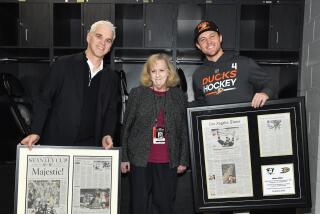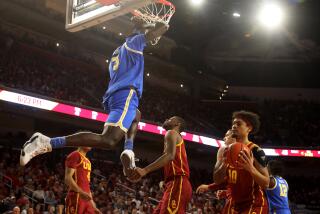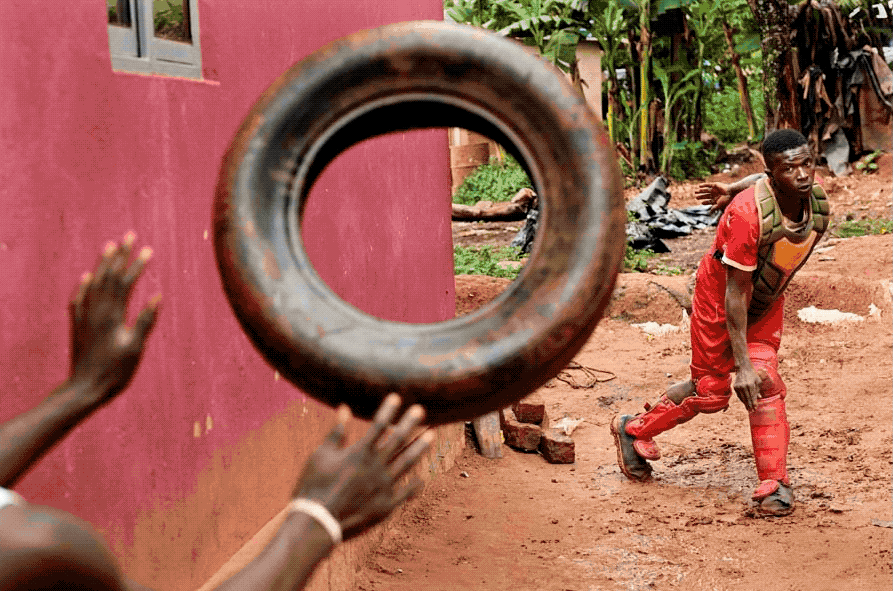He’s Creating Elbow Room in the Middle : Bulls: Cartwright’s style of play inside can be a problem for anyone who doesn’t give him enough space.
Mayhem in the Middle plays on, better than most realize because they are paying so much attention to his elbows--the elbows that inspired an organization to cry out for protection and are part of one of the ugliest jump shots in basketball.
It has played all the way to the NBA finals, where Bill Cartwright, 7 feet 1 not counting the shadow of accusation that follows him, is shooting 55.7% in the Chicago Bulls’ 14 playoff games while also having successfully defended Patrick Ewing, Rick Mahorn and James Edwards. The thing is, he has done it while playing both sides of the drama, villain and sentimental favorite.
Cartwright turns 34 in a little less than two months and is nearing the end of his 12th season since leaving the University of San Francisco. During the course of this season, he nearly wiped out the right eye of Hakeem Olajuwon with an inadvertent elbow while going for a rebound, an event that might have faded quickly except that it wasn’t the first time Cartwright’s limbs had been in the wrong place at the wrong time.
Greg Kite, Fred Roberts and Duane Causwell have been felled by Cartwright, generally because of an accidental elbow. Even a ball boy at Chicago Stadium suffered a broken leg after an out-of-bounds collision.
“The first thing you learn when you’re a kid playing is that when you grab the ball, extend your elbows to protect your space,” Will Perdue, Cartwright’s understudy with the Bulls, said in defense of his teammate. “Apparently, he had a very good teacher.”
Said Laker reserve center Mychal Thompson, who has been facing Cartwright for parts of three decades: “Bill will hit you with elbows more than any part of his body, but it’s not intentional, it’s not malicious. He is just a very active player. You have to be careful and stay out of his way. You want to play defense on him with arms and legs, not your neck.”
When Olajuwon went down and had to be carted out of the Summit on a stretcher, the Houston Rockets, General Manager Steve Patterson in particular, suggested that somebody in power should look into the problem.
The league did, then suggested that Cartwright begin wearing elbow pads. He declined and has made it through the playoffs without incident, except if you consider his reputation around the league.
“It has been a little weird,” Cartwright said of the season, which during one stretch included almost daily defense of his style of play and which has now been capped by his first appearance in the title round.
“Never a dull moment, that’s all. Obviously, there was a little much to-do with the elbows by people out of control, but I’m not going to worry about that. We had 61 wins and established ourselves as a championship team. . . . I take it all with a grain of salt. That’s about what it is worth.”
The people out of control, that would be Patterson and the media, who combined, in Cartwright’s eyes, to blow the issue through the roof. The notion that none of it bothers him may be far less certain.
“Deep down, I think it does,” said Perdue, the third-year backup center. “He won’t tell you that it does, but if there is one thing that can affect a guy for a long time after he retires, it’s that kind of reputation. I think it might bother him then. But right now, he’s just concentrating so much on each game.”
Cartwright is not unlike the Boston Celtics’ Robert Parish, also a center who is reluctant to allow anyone short of close friends a glimpse at the inner workings that have kept him going so long.
Both are far more introspective. Few people know that Cartwright is a collector of 1950s memorabilia--even though his dedication has reached such a level that one room in his house is designed like a diner from that era. But both are also enjoying some of the best years of their careers.
Cartwright hasn’t shot so well in the playoffs since 1983-84, one of his eight seasons with New York. His regular-season percentage of 49% was the best since 1987-88, and his 2,273 minutes were on a level with anything since the 2,925 he played in 1980-81.
The only significant drop has been in scoring, down to a career-low average of 9.6 points a game, partly because the Bulls don’t expect him to score in the high-teens and low-20s he reached as a Knick.
Even as the game has moved away from his preferred style of staying close to the basket in favor of a mobile center, he is more than merely surviving, having played in 79 of 82 games during the regular season for a team that prides itself on an up-tempo transition game. This feat is especially notable for someone whose career supposedly was near an end because of foot problems. That was six seasons ago.
“Centers are expected to do a lot of things,” Cartwright said. “It’s not just going down low and banging and hitting anymore. It’s now about going out to the three-point line, too. I have played all over the last couple years. I’d rather be down there, but I’ve played all over.”
It’s as though followers of the game are supposed to ignore the gray speckles in his goatee.
Or maybe appreciate them.
“It’s like I used to see in the comics,” Perdue said. “He’s the wise old man, and everyone asks him the answer when they only have the question.”
Comic book hero, scourge of opposing centers--the drama continues in full force, much like the man and his career.
More to Read
Go beyond the scoreboard
Get the latest on L.A.'s teams in the daily Sports Report newsletter.
You may occasionally receive promotional content from the Los Angeles Times.










